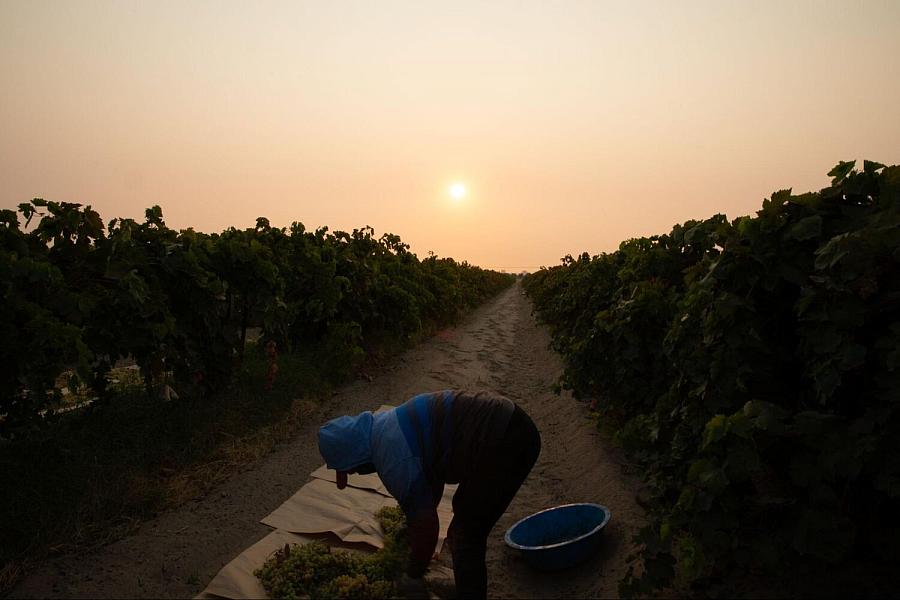Patience was key to telling the story of Indigenous farmworkers and the health care barriers they face

An inside look at one of California’s most invisible communities
(Photo by Zaydee Sanchez/palabra)
In California’s Central Valley fields, Indigenous farmworkers work long shifts, through body pain and soreness, to put food on our tables. But the physical challenge is only one of the significant health obstacles they face. The region has one of the state’s highest rates of asthma and asthma-related hospitalizations, leaving people vulnerable to serious complications from COVID-19. Accessing health care information is a matter of life and death.
Photographer Zaydee Sanchez and I didn’t know what our angle to address health care issues in the Central Valley was going to be until we sat down with the Indigenous community. Silvia Garcia, an Indigenous woman from Guerrero, Mexico, told us that language posed one of the biggest barriers. Most of the Indigenous population does not read or speak Spanish, let alone English. As a result, if an emergency occurs, they are not sure what to do.
There are 165,000 Indigenous farmworkers in California’s Central Valley fields. To connect with these communities took patience and outreach. Zaydee and I spent months on the ground talking to farmworkers. At first, we spoke to anyone. We asked them about working during the pandemic and accessing health care information. We discovered there are potentially hundreds of stories that can be told about their lives, the conditions they work in and the difficulties they face.
Indigenous farmworker communities have several things in common: they are undocumented, they are low-income, and they have limited access, if any, to mainstream health care practices. The health care centers that are available do not have interpreters ready to help them. I called urgent care centers and clinics in the areas surrounding the fields we visited. They did not have anyone who spoke Tlapaneco and had an interpreter for Mixteco only if you call ahead of time.
The law requires that health care information and services be made available in the languages of communities — and Indigenous workers from Mexico have been part of Central Valley communities for decades. “Interpreting is always required under state and federal law. That also includes Indigenous language interpreters too,” said Marisa Lundin of California Rural Legal Assistance. But it’s difficult for these farmworkers to seek changes that would improve access to care, even changes to which they’re entitled.
Zaydee and I wanted to show the daily routine of an Indigenous woman farmworker, to illustrate the challenges the larger community experiences. Getting close enough to profile a women was not easy. We started by establishing a relationship with the United Farm Workers Foundation. Then we attended UFW Foundation vaccine events to build on that relationship. We didn’t connect with someone we might report on for this story at all these events but discovered a basket of other stories we can work on in the future. A UFW organizer contacted Silvia, who was willing to tell us her story.
A big take-away from this project: have patience and respect when building a relationship with a community on the margins of U.S. society. They are a target for local law enforcement and, in some cases, for Immigration and Customs Enforcement.
After connecting with Silvia, my greatest challenge was researching how the language barrier plays a role in the lives of farmworkers. We interviewed multiple experts and advocates. We learned that simple things that non-Indigenous people might take for granted, such as reading pamphlets about COVID safety or vaccines, is not available to Indigenous workers.
In addition to reporting on the ground, I spent several months studying two farmworker research projects and contacting the researchers. The COVID-19 Farmworker Study, developed by a coalition of community-based organizers and researchers from across California, looks at every aspect of workers’ lives during the pandemic. Ildi Carlisle-Cummins, executive director of the California Institute for Rural Studies, was excited we were writing about farmworkers for the fellowship and bringing attention to critical barriers they face.
The second research I studied was from the organization Indigenous Mexicans in California Agriculture. It took a while to connect, but once I did, I received the same enthusiastic response I’d gotten from Carlisle-Cummins.
It was a reminder of how important it is to bring forth stories of those in the shadows. The people who work hard to feed us deserve to be heard.
